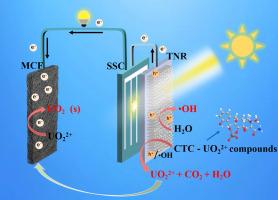Integrated approach to uranium recovery and organic decomposition with electricity generation in a self-driven photoelectrochemical system
IF 6.3
2区 环境科学与生态学
Q1 ENVIRONMENTAL SCIENCES
引用次数: 0
Abstract
Simultaneous uranium recovery, organic pollutant degradation, and electricity generation were achieved by employing a self-driven photoelectrochemical (PEC) system equipped with a modified carbon felt (MCF) cathode for the treatment of complex radioactive wastewater. The MCF cathode was synthesized via a facile hydrothermal method, which modified the surface functional groups on carbon felt (CF) with enhanced active site availability and facilitated interfacial charge transfer, thus improving its UO22+ adsorption and reduction capacities. The self-driven PEC system with the MCF cathode demonstrated remarkable removal efficiencies and rate constants (k) for UO22+ (98.8 % and 0.111 min−1) and chlortetracycline hydrochloride (CTC) (92.9 % and 0.028 min−1) within 40 min and 90 min, respectively, coupled with an excellent power output of 1.41 mW/cm2. Additionally, the system with the MCF cathode exhibited superior removal performance for UO22+ and CTC in treating model complex wastewater under wide conditions. Even under natural sunlight, the system achieved over 80 % removal efficiency for both UO22+ and CTC. Moreover, the uranium immobilized on the MCF cathode was mainly reduced to U(IV) species (90.51 %), and performance remained robust over ten operational cycles. The cathode surface modification strategy and its application in the system provide a cost-effective, multi-functional and high-efficiency approach to controlling nuclides and organic pollutants in complex radioactive wastewater.

自驱动光电化学系统中铀回收和有机分解与发电的集成方法
采用自驱动光电化学(PEC)系统,配以改性碳毡(MCF)阴极处理复杂的放射性废水,实现了铀回收、有机污染物降解和发电的同时进行。采用水热法合成了MCF阴极,对碳毡表面官能团进行了修饰,提高了活性位点利用率,促进了界面电荷转移,从而提高了MCF阴极对UO22+的吸附和还原能力。采用MCF阴极的自驱动PEC系统在40 min和90 min内对UO22+(98.8%和0.111 min−1)和盐酸氯四环素(92.9%和0.028 min−1)的去除率和速率常数(k)分别达到了显著的效率,输出功率达到1.41 mW/cm2。此外,在广泛的条件下,MCF阴极系统对UO22+和CTC的去除效果也很好。即使在自然光照下,该系统对UO22+和CTC的去除效率也超过80%。此外,固定在MCF阴极上的铀主要被还原为U(IV)种(90.51%),并且在10个运行周期内性能保持稳定。阴极表面改性策略及其在系统中的应用为控制复杂放射性废水中的核素和有机污染物提供了一种经济、多功能、高效的方法。
本文章由计算机程序翻译,如有差异,请以英文原文为准。
求助全文
约1分钟内获得全文
求助全文
来源期刊

Journal of Environmental Sciences-china
环境科学-环境科学
CiteScore
13.70
自引率
0.00%
发文量
6354
审稿时长
2.6 months
期刊介绍:
The Journal of Environmental Sciences is an international journal started in 1989. The journal is devoted to publish original, peer-reviewed research papers on main aspects of environmental sciences, such as environmental chemistry, environmental biology, ecology, geosciences and environmental physics. Appropriate subjects include basic and applied research on atmospheric, terrestrial and aquatic environments, pollution control and abatement technology, conservation of natural resources, environmental health and toxicology. Announcements of international environmental science meetings and other recent information are also included.
 求助内容:
求助内容: 应助结果提醒方式:
应助结果提醒方式:


